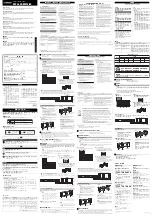
Page 51 of 91
Rev. 4.20
9.4.1 Logic states
For the outputs we have 4 defined logic states:
TYPE
DESCRIPTION
deactivated
The output is not ready.
activated
The output is ready.
armed
The condition for the activation of the output is real but the output
itself is not activated since it is programmed to have a delayed
activation. Once the delayed time is elapsed, the output is activated
(providing the activation condition is still “real”). If the
activation condition becomes “false” the output will deactivates
itself. It is possible, once enabled, the delete the delay function of
the output by following the specific procedures (see below).
silenced
The condition of the output activation is “real”, but the output is
not armed because the user has executed a total silence function (from
armed output or active). The output can only be activated from a
general or total output activation function which is executed by the
user (in the case that the activation condition is still considered
“REAL”). If the activation condition becomes “false” the output will
deactivate itself.
Note:
ü
Even if they are set up, the delays for the outputs are actually taken into account only in the case where
certain conditions occur (see below).
ü
For the sensor’s outputs, the activation delays cannot be set up, therefore they can’t be as an armed
output.
ü
For the loop outputs, even without a delay, there is a slight delay of activation but is due to the necessary
time required by the control panel to start up the activation circuitry. So this slight delay cannot be
eliminated. This delay is always inferior to ten seconds.
9.4.2 Logic of activation
There are 3 exit groups defined by their activation purpose:
1.
Outputs activated on fire alarm status.
2.
Outputs activated on zone repeater.
3.
Outputs activated on alarm status different from fire.
GROUP 1
For the Group 1 outputs, the following conditions apply:
1.1 The control panel must be in fire alarm status, or else the output will not be activated.
1.2 If there at least one zone which is in “not delayed” function among the ones in output alarm, it will be
forced to “0” the delayed time.
1.3 If the control panel is in evacuation status, the output becomes active with a forced “0” delay time.
1.4 If the control panel is not in supervised mode, the output becomes active with a forced ”0” delay time.
1.5 If the conditions 1.2...1.4 are “false”, the following conditions apply:
1.5.1
If the output is not activated the “manual 0 delay option” this is set up with the delay it is given,
not to be delayed with “0” value.
1.5.2
If the “manual 0 delay option” is activated for the output:
1.5.2.1
If the <=1 buttons are pressed for the manual alarm outputs the delay time can be set
by the user, it can be Zeroed by pressing the >=2 buttons or by directly from the
evacuation menu for total deletion on the control panel.
1.5.2.2
If the >=1 buttons are pressed for the manual alarm output, it is activated with a forced
“0” delay.
GROUP 2
For the group 2 outputs the following conditions apply:
2.1 At least one of the two zones in output must be armed, otherwise the output will not be activated.
2.2 If there is at least one zone “not delayed” among the armed ones in output repetition, this will be activated
with forced delay 0 value.
2.3 If the control panel is in evacuation status the output becomes active under forced delay 0 value.
















































